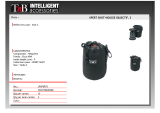TABLE OF CONTENTS
Power Xpert 9395 UPS (450–550 kVA) Installation and Operation Manual 164201701 Rev 4 www.eaton.com/powerquality
vii
Figure 6‐2. Path of Current Through the UPS in Online Mode 6-3......................................................
Figure 6‐3. Path of Current Through the UPS in Energy Saver Mode 6-4.................................................
Figure 6‐4. Path of Current Through the UPS in Bypass Mode 6-6......................................................
Figure 6‐5. Path of Current Through the UPS in Battery Mode 6-7.....................................................
Figure 6‐6. UPS System – Common Rectifier Feed, Common Battery, Dual‐Feed Configuration 6-9..............................
Figure 6‐7. UPS System – Common Rectifier Feed, Separate Battery, Dual‐Feed Configuration 6-10..............................
Figure 6‐8. Plus 1 UPS System – Common Rectifier Feed, Common Battery, Dual‐Feed Configuration 6-11.........................
Figure 6‐9. Plus 1 UPS System – Common Rectifier Feed, Separate Battery, Dual‐Feed Configuration 6-12.........................
Figure 6‐10. UPS System – Common Rectifier Feed, Common Battery, IOM Configuration 6-13..................................
Figure 6‐11. UPS System – Common Rectifier Feed, Separate Battery, IOM Configuration 6-14.................................
Figure 6‐12. Plus 1 UPS System – Common Rectifier Feed, Common Battery, IOM Configuration 6-15.............................
Figure 6‐13. Plus 1 UPS System – Common Rectifier Feed, Separate Battery, IOM Configuration 6-16.............................
Figure 6‐14. UPS System – Separate Rectifier Feed, Separate Battery, Dual‐Feed Configuration 6-17.............................
Figure 6‐15. Plus 1 UPS System – Separate Rectifier Feed, Separate Battery, Dual‐Feed Configuration 6-18........................
Figure 6‐16. UPS System – Separate Rectifier Feed, Separate Battery, IOM Configuration 6-19.................................
Figure 6‐17. Plus 1 UPS System – Separate Rectifier Feed, Separate Battery, IOM Configuration 6-20............................
Figure 6‐18. Simplified Dual-Feed UPS with Maintenance Bypass Panel 6-21..............................................
Figure 6‐19. Path of Current through the UPSs in Online Mode – Distributed Bypass 6-23.....................................
Figure 6‐20. Path of Current through the UPSs in Bypass Mode – Distributed Bypass 6-24.....................................
Figure 6‐21. Path of Current through the UPSs in Battery Mode – Distributed Bypass 6-26.....................................
Figure 6‐22. Typical Distributed Bypass System (1+1 and 2+0 Configurations) 6-28..........................................
Figure 6‐23. Typical Distributed Bypass System (2+1 and 3+0 Configurations) 6-29..........................................
Figure 6‐24. Typical Distributed Bypass System (3+1 and 4+0 Configurations) 6-30..........................................
Figure 7‐1. UPS Controls and Indicators (Front Doors Removed) 7-1....................................................
Figure 7‐2. UPS Control Panel 7-2............................................................................
Figure 7‐3. Parts of the LCD 7-4.............................................................................
Figure 7‐4. Main Menu and Mimic Screen (Online Mode) 7-5........................................................
Figure 7‐5. Typical System Status Screen 7-8...................................................................
Figure 7‐6. Load Off Screen 7-10.............................................................................
Figure 7‐7. REPO Operation 7-25.............................................................................
Figure 7‐8. Color Touchscreen Control Panel Location (Typical) 7-45.....................................................
Figure 7‐9. UPS Color Touchscreen Control Panel (Typical) 7-46........................................................
Figure 7‐10. Parts of the Touch Screen 7-47......................................................................
Figure 7‐11. Sign In or Password Request Screen 7-48..............................................................
Figure 7‐12. Home Screen 7-49..............................................................................
Figure 7‐13. Main Menu and Power Maps Screen (Online Mode) 7-50...................................................
Figure 7‐14. Load kVA Screen from Home Screen 7-50..............................................................
Figure 7‐15. Average Efficiency Screen from Home Screen 7-51.......................................................
Figure 7‐16. Consumption Screen from Home Screen 7-51...........................................................
Figure 7‐17. Bypass Screen 7-52.............................................................................
Figure 7‐18. Typical Command Confirmation Screen (Charger Off) 7-52..................................................
Figure 7‐19. Meters Summary Screen 7-53......................................................................
Figure 7‐20. Input Meters Screen 7-54.........................................................................
Figure 7‐21. Bypass Meters Screen 7-54........................................................................
Figure 7‐22. Output Meters Screen 7-55........................................................................
Figure 7‐23. Input Meters Detail Screen 7-56....................................................................
Figure 7‐24. Select Source Screen 7-56.........................................................................
Figure 7‐25. Battery Meters Screen 7-57........................................................................
Figure 7‐26. Battery Log Screen 7-57..........................................................................
Figure 7‐27. Battery Log Detail 7-58...........................................................................
Figure 7‐28. Battery Log Summary Screen 7-58...................................................................





















